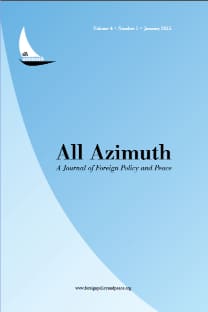An Empirical Assessment of the Role of Emotions and Behavior in Conflict Using Automatically Generated Data*
An Empirical Assessment of the Role of Emotions and Behavior in Conflict Using Automatically Generated Data*
___
- Ajzen, Icek. Attitudes, Personality, and Behavior. Chicago: Dorsey Press, 1988.
- Bond, Doug, Craig Jenkins, and Kurt Schock. Mapping Mass Political Conflict and Civil Society: Issues and Prospects for the Automated Development of Event Data. Journal of Conflict Resolution 41 (1997): 553-579.
- Cottrell, Catherine A. and Steven L. Neuberg. Different Emotional Reactions to Different Groups: a Sociofunctional Threat-based Approach to Prejudice. Journal of Personality and Social Psychology 88 (5) (2005): 770-789. Ekman, P. An Argument for Basic Emotions. Cognition and Emotion 6 (3-4) (1992): 169-200.
- Esty, Daniel C., Jack Goldstone, Ted Robert Gurr, Pamela Surko, and Alan N. Unger. Working Papers: State Failure Task Force Report. McLean, VA: Science Applications International Corporation, 1995. Accessed June 8, 2009. http://www.allacademic.com/meta/p312200_index.html.
- Esty, Daniel C., Jack Goldstone, Ted Robert Gurr, Barbara Harff, Marc Levy, Geoffrey D. Dabelko, Pamela T. Surko, and Alan N. Unger. The State Failure Task Force Report: Phase II Findings. McLean, VA: Science Applications International Corporation, 1998. Accessed June 8, 2009. http://globalpolicy.gmu.edu/pitf/SFTF%20Phase%20 II%20Report.pdf.
- Kuppens, Peter, Iven Van Mechelen, Dirk J.M. Smits, Paul De Boeck. The Appraisal Basis of Anger: Specificity, Necessity and Sufficiency of Components. Emotion 3 (3) (2003): 254-269.
- Lake, David H. and Powell, Robert. International Relations: A Strategic-Choice Approach. In Strategic Choice and International Relations, edited by David H. Lake and Robert Powell. Princeton, NJ: Princeton University Press, 1999.
- Lerner, Jennifer S. and Keltner, Dacher. Fear, Anger, and Risk. Journal of Personality and Social Psychology 81(1) (2001): 146-159.
- Matsumoto, David, Hyisung C. Hwang and Mark G. Frank. Emotional Language and Political Aggression. Journal of Language and Social Psychology XX (X) (2013):1-17. Accessed May 8, 2013. DOI: 10.1177/0261927X12474654
- OBrien, Sean P. Anticipating the Good, the Bad, and the Ugly: An Early Warning Approach to Conflict and Instability Analysis. Journal of Conflict Resolution 46 (2002): 791-811.
- Petraeus, David H., and James F. Amos. U.S. Army/U. S. Marine Corps Counterinsurgency Field Manual. Chicago: University of Chicago Press, 2007.
- Plutchik, Robert. Emotion, a Psychoevolutionary Synthesis. New York: Harper and Row, 1980.
- Schrodt, Philip A., and Deborah J. Gerner. Empirical Indicators of Crisis Phase in the Middle East, 19791995. Journal of Conflict Resolution 41 (1997): 529-552.
- Schrodt, Philip A., Shannon G. Davis, and Judith L. Weddle. Political Science: KEDS―A Program for Machine Coding Events Data. Social Science Computer Review 12 (3) (1994): 561-88.
- Shellman, Stephen M. Leaders and Their Motivations: Explaining Government-Dissident Conflict-Cooperation Processes. Conflict Management & Peace Science 23 (1) (2006a): 73-90.
- Shellman, Stephen M. Process Matters: Conflict and Cooperation in Sequential Government-Dissident Interactions. Security Studies 15 (4) (2006b): 563-599.
- Shellman, Stephen M. Taking Turns: A Theory and Model of Government-Dissident Interactions. Saarbrucken: VDM Verlag, 2010.
- Shellman, Stephen M., Clare J. Hatfield, and Maggie J. Mills. Disaggregating Actors in Intrastate Conflict. Journal of Peace Research 47 (1) (2010): 83-90.
- Shellman, Stephen M., Brian P. Levey, and Joseph K. Young. Shifting Sands: Predicting Phase Shifts by Dissident Organizations. Journal of Peace Research 50 (3) (2013): 319-336, DOI:10.1177/0022343312474013.
- Singer, J. David and Melvin Small. The Wages of War, 1816-1965: A Statistical Handbook. New York: John Wiley and Sons, 1972.
- Wallensteen, Peter and Margareta Sollenberg. Armed Conflict 1989-98. Journal of Peace Research 36 (5) (1999): 593-606.
- Wilkenfeld, Jonathan, Michael Brecher, and Sheila Moser. Crises in the Twentieth Century: Handbook of Foreign Policy Crises. Oxford, England: Pergamon Press, 1988.
- ISSN: 2146-7757
- Yayın Aralığı: 2
- Başlangıç: 2012
- Yayıncı: Dış Politika ve Barış Araştırmaları Merkezi, İhsan Doğramacı Barış Vakfı
A Guide to Event Data: Past, Present, and Future
Data Quality for Measuring Political Protest and Government Change
Roundtable Discussion on Event Data
Ersel Aydınlı, Özgür Özdamar, Pınar İpek, Balkan Devlen, Belgin Şan Akça, Haluk Özdemir, Saize Arsavun, Joseph Bond, Reşat Bayer, William Lowe, Curtis Signorino, Sean O'Brien, James Yonamine, Cihangir Baycan, Ertan Efegil, Musa Tüzüner
